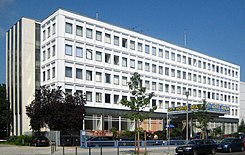Glinkastrasse
| Glinkastrasse | |
|---|---|
| Street in Berlin | |
| Former consulate building at Glinkastrasse 5–7 on the grounds of the North Korean Embassy |
|
| Basic data | |
| place | Berlin |
| District | center |
| Created | May 31, 1951 |
| Hist. Names | Kanonierstrasse (1700–1951) |
| Connecting roads |
Neustädtische Kirchstrasse (north) , Mauerstrasse (south) |
| Cross streets |
Behrenstrasse , Französische Strasse , Jägerstrasse , Taubenstrasse , Mohrenstrasse |
| use | |
| User groups | Pedestrian traffic , bicycle traffic , car traffic |
| Technical specifications | |
| Street length | 610 meters |
The Glinkastraße is since May 31, 1951 after the Russian composer Mikhail Glinka named street in the Berlin district of Mitte of the district of the same . It had previously been known as Kanonierstrasse since the beginning of the 18th century .
Course and history
The street runs in a north-south direction parallel to Friedrichstraße , from the boulevard Unter den Linden to Kronenstraße, where it turns into Mauerstraße . The traffic route was laid out as a Kanonierstrasse around 1700 and led from Kronenstrasse (at the Dreifaltigkeitskirche ) via Jägerstrasse and Französische Strasse to Behrenstrasse . In the 18th century there were 46 horseshoe numbered houses along the street . The street name is said to stem from the fact that in the 16./17. In the 18th century there was a guardhouse with a cannon at the southern end of this street, where the soldiers had to do their service.
As a result of the destruction of the area in the Second World War and the subsequent clearing of the rubble land , the street was renamed and extended from Behrenstraße to Unter den Linden.
On July 3, 2020, the BVG announced that the neighboring Mohrenstrasse subway station would be renamed “Glinkastrasse”. A date for the renaming has not been specified.
Adjacent buildings

In the northern part of Glinkastrasse there is part of the Russian Embassy in Berlin . The Berlin office of the Federal Ministry for Family, Seniors, Women and Youth is located at Glinkastraße 24 . The headquarters of the German Social Accident Insurance (DGUV) has been located at Glinkastraße 40 since October 20, 2014. The North Korean Embassy has its headquarters in buildings No. 5–7, which was built between 1972 and 1974 Property also ran a hostel . The metal entrance door to house number 7 was created in the workshop of the metal artist Achim Kühn .
Until November 1943, the baroque Dreifaltigkeitskirche at the intersection of Mauerstraße, Glinka- und Mohrenstraße was a landmark. It was destroyed in an air raid. Two of the original three rectory houses on the corner property at Glinkastraße 16 and Taubenstraße 3, which have been used as residential buildings and community centers since the 1980s, have been preserved.
After the fall of the Berlin Wall , numerous renovations and new construction works were carried out in this and neighboring street. On this occasion in 2008 the location and part of the floor plan of the church were made visible again in the form of a paving mosaic.
A four-storey building complex, Glinkastraße 27-43, with two connecting bridges across the street, one on French Street, was built in 1872 as headquarters of Deutsche Bank built in custom style followed in 1901 a place of business for the North Star Life Insurance .
After the founding of the GDR , the entire building became the seat of the GDR Interior Ministry and remained so until the GDR was dissolved as a result of German reunification . On February 15, 1991, on the initiative of high-ranking officials from the Ministry for State Security (MfS), which was dissolved at the beginning of 1990, representatives of the Federal Office for the Protection of the Constitution (President of the Federal Office for the Protection of the Constitution Gerhard Boeden and his deputy Eckart Werthebach) and the Federal Minister of the Interior Wolfgang Schäuble met with the last Head of the head of the intelligence department of the MfS Werner Großmann and former Stasi generals (Günter Kratsch, Günter Möller, Gerhard Niebling, Heinz Engelhardt) met. On a secret mission, they negotiated the question of what should happen to the previously undiscovered GDR spies. On the one hand, later criminal prosecution was to be averted, on the other hand, the takeover of the spies by other secret services was to be prevented. The exact result was not known.
The building, which has since been beautifully restored, served as the temporary headquarters of the USA production company Homeland in 2015 . Because the fifth season of the series of the same name about the CIA was shot in Berlin. The complex has been mostly empty since the 2010s, is a listed building and has been expanded to become the new Berlin headquarters of the Federal Ministry of Health and for use by other ministries since 2018 .
Web links
- Glinkastrasse. In: Street name lexicon of the Luisenstädtischer Bildungsverein (near Kaupert )
- Gunnery Street . In: Luise.
Individual evidence
- ^ Kanonierstrasse . In: Street name lexicon of the Luisenstädtischer Bildungsverein
- ↑ https://www.morgenpost.de/bezirke/mitte/article229221364/Hostel-auf-Nordkoreas-Botschaftsgelaende-ist- Closed.html
- ↑ Photo of the entrance door at Glinkastraße on www.flickr.com
- ↑ a b Volker Becker: On quiet ways . In: The property . Journal of the Association of German Land Users, 7 (2017), pp. 28/29.
- ↑ Monument complex Mauerstraße 25–32, 39–42; Behrenstrasse 9-13; French Street 1-7; 63-68 Glinkastrasse 27/43; Jägerstrasse 72-76; Deutsche Bank, 1872–1874. Architects Ende & Böckmann; Expansion in 1914 by Hans Jessen and - after 1945 - reconstruction according to plans by Hans Ehrlich.
- ↑ Presentation by the project manager of the PPP project, Mayk Zieschang
Coordinates: 52 ° 30 ′ 49.8 " N , 13 ° 23 ′ 10.8" E

